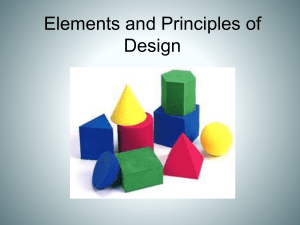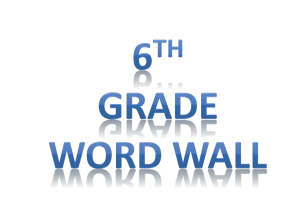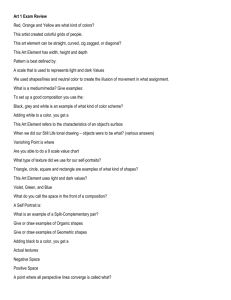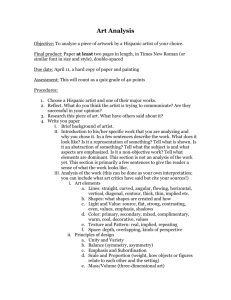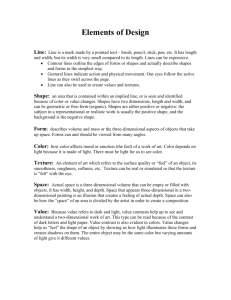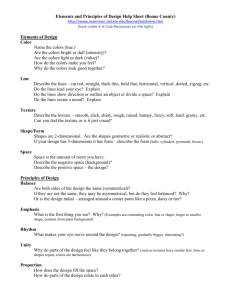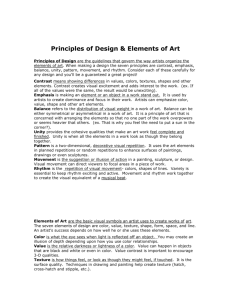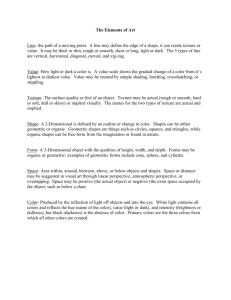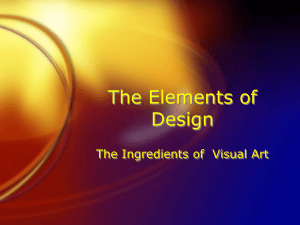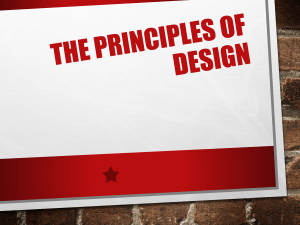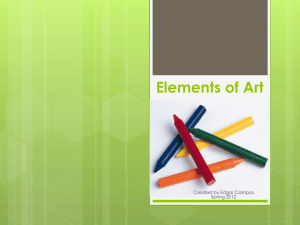Medium- A term used generally to describe both the various
advertisement
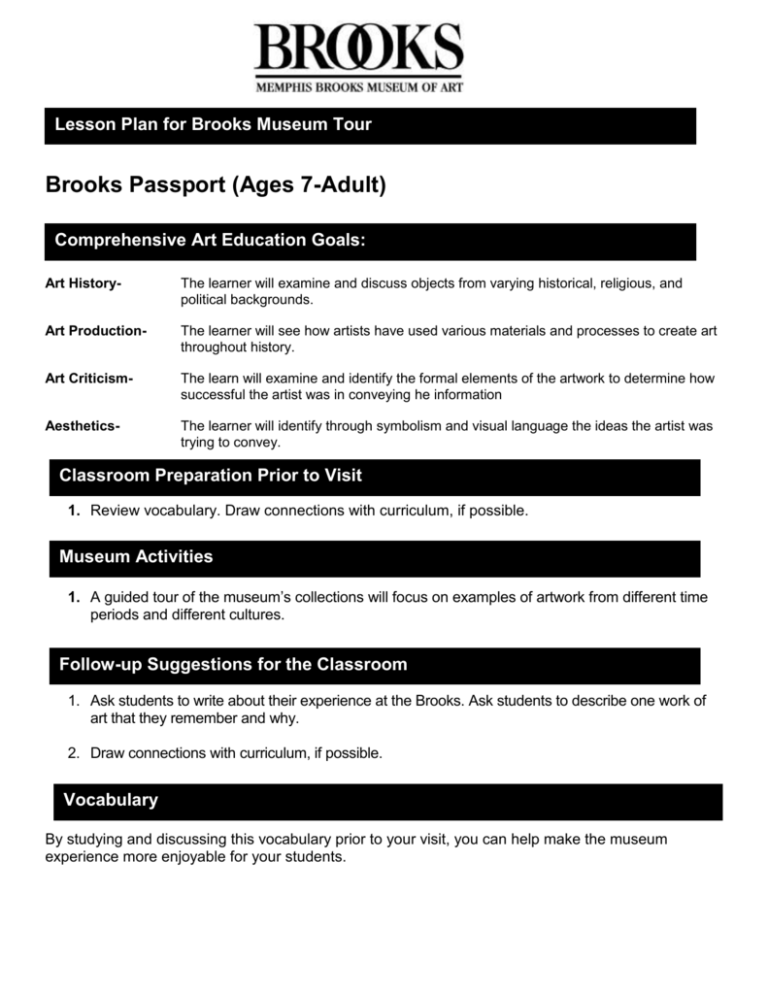
Lesson Plan for Brooks Museum Tour Brooks Passport (Ages 7-Adult) Comprehensive Art Education Goals: Art History- The learner will examine and discuss objects from varying historical, religious, and political backgrounds. Art Production- The learner will see how artists have used various materials and processes to create art throughout history. Art Criticism- The learn will examine and identify the formal elements of the artwork to determine how successful the artist was in conveying he information Aesthetics- The learner will identify through symbolism and visual language the ideas the artist was trying to convey. Classroom Preparation Prior to Visit 1. Review vocabulary. Draw connections with curriculum, if possible. Museum Activities 1. A guided tour of the museum’s collections will focus on examples of artwork from different time periods and different cultures. Follow-up Suggestions for the Classroom 1. Ask students to write about their experience at the Brooks. Ask students to describe one work of art that they remember and why. 2. Draw connections with curriculum, if possible. Vocabulary By studying and discussing this vocabulary prior to your visit, you can help make the museum experience more enjoyable for your students. Formal Characteristics Composition- Describes the arrangement of parts to present a unified image. Terms used to identify major principles of composition are: unity, balance, emphasis directional forces, contrast, repetition and rhythm, scale and proportion. Color- When light is reflected off an object, color is what the eye sees. The primary colors are red, yellow and blue. All other colors can be mixed or produced from these colors. Line- A continuous mark made on a surface. Lines can vary in length width texture, direction, curve, etc. Lines can be used alone or combined to create shapes. Shape- When two lines meet and enclose space, such as a circle drawn on paper. Geometric shapes are simple curves and straight lines enclosed to form circles, squares, etc. Free form or organic shapes are irregular shapes. Form- When a shape encloses space and takes up space, form is 3-dimensional. Sculptures are forms, but form can also be implied in painting, drawing, and printmaking by using perspective, shading, etc. Space- Space is defined and determined by shapes and forms. Positive space is where shapes and forms exist. Unity- Describes how Elements of Art are arranged in a composition to achieve a whole. A composition can be unified by shape, color, line, etc. Emphasis- Describes an area in a composition that first attracts the viewers’ attention. This area is more important when compared to other Elements in a composition. Where an artist places emphasis gives viewers clues about the intended meaning of the work Balance/ Symmetry- Describes how Elements of Art are arranged to create a feeling of stability in a work. An artist may intentionally arrange Elements out of balance to create emphasis, tension or a certain mood. Scale/ Proportion- Describes the size of an Element in a composition in relation to its surroundings. Rhythm/ Movement- Describes the path our eyes follow when we look at a work of art. Repetition: A way of combining Elements of Art so that the same elements are used over and over again. Repetition creates pattern and contributes to movement and rhythm in a work of art. Perspective- An artistic method used to accurately represent a particular space on a two dimensional surface. Atmospheric perspective describes a process where the colors and sizes of object diminish with distance. Linear perspective describes a process where a vanishing point creates the illusion of space and depth. Polychromatic-A term meaning painted, printed, or decorated in many different colors. Texture- The surface quality of feel of an object or image (smooth, rough, soft); texture can be actual or implied. Implied texture is suggested by the way an artist uses line, shape, and color. Border- A part that forms the outer edge of something. Tripartite- Composed of or divided into three parts Materials TemperaA type of paint made my mixing colored pigments and egg yolk. MediumA term used generally to describe both the various methods and materials used by art Earthenware- A ceramic material commonly used for tableware and decorative objects. Earthenware is fired at a low temperature, is more fragile than stoneware, and remains porous unless treated with a glaze. Marble- A metamorphic rock formed by alteration of limestone or dolomite, often irregularly colored by impurities, and used especially in architecture and sculpture. Creative Process/Forms: en plein air- A French expression that means, “ in open air “ in other words, painted outdoors. Casting- A sculptural process that involves pouring liquid metal, plaster or clay into a mold to create a three-dimensional shape. Carving- The cutting of a material such as wood or stone to create a figure or a design. Statue- Three dimensional form of a person or animal sculpted, carved, modeled, or cast in any material, usually an entire figure, and especially when done in the round rather than in relief. Fresco- A painting technique in which pigment is applied onto fresh, wet, plaster. When the plaster dries, the pigment becomes part of the wall itself. Mural- A large work of art painted on a wall, ceiling, or other permanent surface. Additional Vocabulary Historical- of, relating to, or having the character of history. Symbol- Any kind of shape, sign, form, pattern, color or line which is used by the artist to express abstract ideas or hidden meanings Proverb- An old and common saying; a phrase, which is often repeated, especially a sentence which briefly and forcibly expresses some practical truth or the result of experience and observation. Myth- A traditional sacred story, typically revolving around the activities of gods and heroes, which purports to explain a natural phenomenon or cultural practice. Society- A voluntary association or organized group working together or periodically meeting because of common interest, belief, or profession Veduta- (plural: vedute) A highly detailed, topographically accurate landscape painting, as opposed to a fanciful one. Please contact the Education Department at (901) 544-6215 if you have questions.
